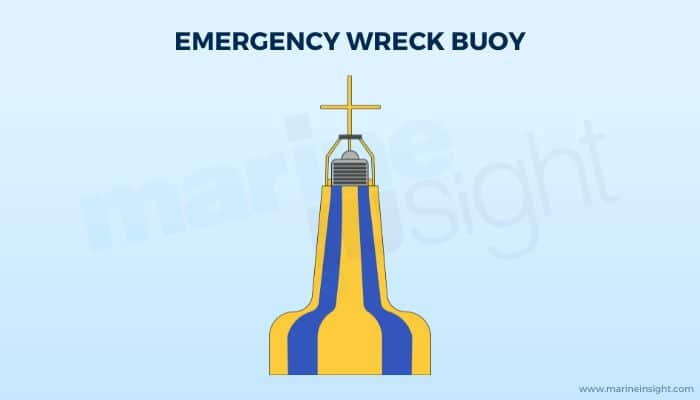What is an Emergency Wreck Marking Buoy?
In our previous articles, we learned about safe water marks and cardinal marks used at sea for a litany of purposes. We saw how each mark is designed to identify itself as a unique symbol suited for a specific indication, mostly a hazard or risk.
In this article, we shall discuss one specific type of sea mark known as the emergency wreck marking buoy.
What is an emergency wreck marking buoy?
As the name suggests, an emergency wreck marking buoy is used to identify and mark wreckages at sea, at least temporarily.
Though, for all practical purposes, we mean shipwrecks or flotsams while speaking of wreckages at sea, these kinds of marks are also used to mark other critical points of interest like damaged civil or offshore structures at sea, abnormally discovered natural formations like new sandbanks or reefs, some obstruction created due to a ship accident like fallen containers or stone chips, large debris, or even wrecks of other bodies like aircraft or submarines.
The primary objective of these marks is to immediately cordon off affected areas at sea from moving traffic and reduce the chances of a further collision, especially during the night or low visibility.
The need for these emergency wreck marking buoys to be exclusively used during such occasions gained prominence in the wake of the 2002 accident of the car carrier vessel Tricolour whose wreck further collided with three other passing vessels successively within a few days.
The International Association of Marine Aids to Navigation and Lighthouse Authorities (IALA), the regulatory body responsible for proposing guidelines for navigational aids and signals, laid out the application for such special marks that became effective in 2005.
As per the current requirements, it is now mandatory to dispose of these markings in the way of any newly discovered wreckages and should be kept in place until:
- The wreck is now well-identified and properly circulated to navigators and seafarers using the route.
- In the case of a submerged wreck, the wreck has been comprehensively inspected, and all its details have been made well aware.
- The wreck has been permanently cordoned off by some means, and some kind of permanent marking has been provided, especially in natural formations or wrecks that have been fully or partially difficult to remove.
- The wreck has been salvaged.
For all practical purposes, these emergency wreck-marking buoys stay in place for not more than 3 to 4 days. They are often replaced by other kinds of marks, like cardinal marks, in case they are not salvaged. Henceforth, it can be said that emergency wreck marking buoys are temporary means to mark an affected area like a wreck.
As per IALA guidelines, the design, construction and disposition of emergency wreck marking buoys are also unique like other kinds of sea marks. They are essentially pillars or spar buoys that remain afloat in water. Their colour coding is mainly characteristic of alternate yellow and blue stripes.
The number of such stripes depends on the size. The size of these marks varies based on the kind of wreckage but needs to be above a certain minimum requirement. Mostly they are conical at the top and have a flat circular base at the bottom (spar buoys) or are slender (pillar buoys) but can be of other forms.
Usually, at the topmost tip or apex, they have a cross mark. Sometimes, the word “WRECK” is also imprinted on it for convenience.
During the dark, they have a unique lighting system. They have a flashlight/beacon fitted on them that emits blue and yellow light flashes at regular intervals. Blue and yellow light flashes for a short duration of 1 second, and the interval between two successive flashlights is usually around 0.5 seconds.
The disposition and number of these buoy marks depend on the type of wreck and expanse. For wrecks or debris spread over a large area, more such marks are used and arranged to aid navigators in the best visual manner possible.
You might also like to read-
- What are tricing pendants and browsing tackles?
- What do you mean by transit bearing?
- What are Chocks On Ships?
- What is Underwater Keel Clearance?
Disclaimer: The authors’ views expressed in this article do not necessarily reflect the views of Marine Insight. Data and charts, if used in the article, have been sourced from available information and have not been authenticated by any statutory authority. The author and Marine Insight do not claim it to be accurate nor accept any responsibility for the same. The views constitute only the opinions and do not constitute any guidelines or recommendations on any course of action to be followed by the reader.
The article or images cannot be reproduced, copied, shared or used in any form without the permission of the author and Marine Insight.
Do you have info to share with us ? Suggest a correction
Latest Marine Navigation Articles You Would Like:
Subscribe To Our Newsletters
By subscribing, you agree to our Privacy Policy and may receive occasional deal communications; you can unsubscribe anytime.
Web Stories

About Author
Subhodeep is a Naval Architecture and Ocean Engineering graduate. Interested in the intricacies of marine structures and goal-based design aspects, he is dedicated to sharing and propagation of common technical knowledge within this sector, which, at this very moment, requires a turnabout to flourish back to its old glory.






















